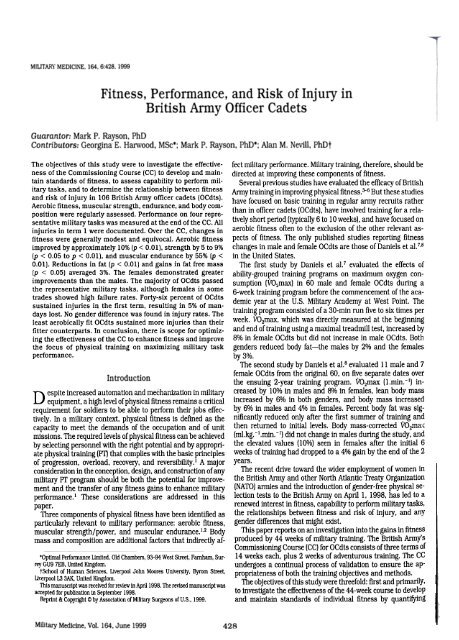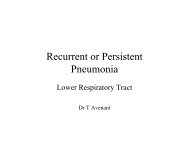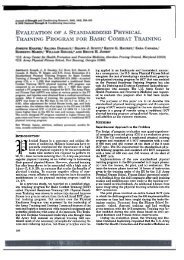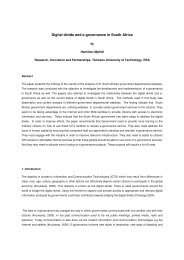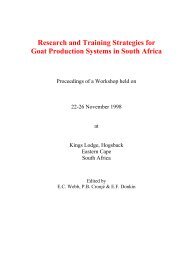Fitness, Performance, and Risk of Injury in British Army Officer Cadets
Fitness, Performance, and Risk of Injury in British Army Officer Cadets
Fitness, Performance, and Risk of Injury in British Army Officer Cadets
You also want an ePaper? Increase the reach of your titles
YUMPU automatically turns print PDFs into web optimized ePapers that Google loves.
MILITARY MEDICINE. 164.6:428. 1999<br />
<strong>Fitness</strong>, <strong>Performance</strong>, <strong>and</strong> <strong>Risk</strong> <strong>of</strong> <strong>Injury</strong> <strong>in</strong><br />
<strong>British</strong> <strong>Army</strong> <strong>Officer</strong> <strong>Cadets</strong><br />
Guarantor: Mark P. Rayson. PhO<br />
Contributors: Georg<strong>in</strong>a E. Har\vood, MSc*; Mark P. Rayson. PhO*; Alan M. Nevill. PhOt<br />
The objectives <strong>of</strong> this study were to <strong>in</strong>vestigate the effectivefect military perfonnance. Military tra<strong>in</strong><strong>in</strong>g, therefore, should be<br />
ness <strong>of</strong> the Commission<strong>in</strong>g Course (CC) to develop <strong>and</strong> ma<strong>in</strong>ta<strong>in</strong><br />
st<strong>and</strong>ards <strong>of</strong> fitness, to assess capability to perform military<br />
tasks, <strong>and</strong> to determ<strong>in</strong>e the relationship between fitness<br />
<strong>and</strong> risk <strong>of</strong> <strong>in</strong>jury <strong>in</strong> 106 <strong>British</strong> <strong>Army</strong> <strong>of</strong>ficer cadets (OCdts).<br />
Aerobic fitness, muscular strength, endurance, <strong>and</strong> body composition<br />
were regularly assessed. <strong>Performance</strong> on four representative<br />
military tasks was measured at the end <strong>of</strong> the CC. All<br />
<strong>in</strong>juries <strong>in</strong> term 1 were documented. Over the CC, changes <strong>in</strong><br />
directed at improv<strong>in</strong>g these components <strong>of</strong> fitness.<br />
Several previous studies have evaluated the efficacy <strong>of</strong> <strong>British</strong><br />
<strong>Army</strong> tra<strong>in</strong><strong>in</strong>g <strong>in</strong> improv<strong>in</strong>g physical fitness.3-6 But these studies<br />
have focused on basic tra<strong>in</strong><strong>in</strong>g <strong>in</strong> regular anny recruits rather<br />
than <strong>in</strong> <strong>of</strong>ficer cadets (OCdts), have <strong>in</strong>volved tra<strong>in</strong><strong>in</strong>g for a relatively<br />
short period (typically 6 to 10 weeks), <strong>and</strong> have focused on<br />
aerobic fitness <strong>of</strong>ten to the exclusion <strong>of</strong> the other relevant as-<br />
fitness were generally modest <strong>and</strong> equivocal. Aerobic fitness pects <strong>of</strong> fitness. The only published studies report<strong>in</strong>g fitness<br />
improved by approximately 10% (p < 0.01), strength by 5 to 9% changes <strong>in</strong> male <strong>and</strong> female OCdts are those <strong>of</strong> Daniels et al!8<br />
(p < 0.05 to P < 0.01), <strong>and</strong> muscular endurance by 55% (p < <strong>in</strong> the United States.<br />
0.01). Reductions <strong>in</strong> fat (p < 0.01) <strong>and</strong> ga<strong>in</strong>s <strong>in</strong> fat free mass<br />
(p < 0.05) averaged 3%. The females demonstrated greater<br />
improvements than the males. The majority <strong>of</strong> OCdts passed<br />
the representative military tasks, although females <strong>in</strong> some<br />
trades showed high failure rates. Forty-six percent <strong>of</strong> OCdts<br />
susta<strong>in</strong>ed <strong>in</strong>juries <strong>in</strong> the first term, result<strong>in</strong>g <strong>in</strong> 5% <strong>of</strong> m<strong>and</strong>ays<br />
lost. No gender difference was found <strong>in</strong> <strong>in</strong>jury rates. The<br />
least aerobically fit OCdts susta<strong>in</strong>ed more <strong>in</strong>juries than their<br />
fitter counterparts. In conclusion, there is scope for optimiz-<br />
The first study by Daniels et al.7 evaluated the effects <strong>of</strong><br />
ability-grouped tra<strong>in</strong><strong>in</strong>g programs on maximum oxygen consumption<br />
(VO2max) <strong>in</strong> 60 male <strong>and</strong> female OCdts dur<strong>in</strong>g a<br />
6-week tra<strong>in</strong><strong>in</strong>g program before the commencement <strong>of</strong> the academic<br />
year at the U.S. Military Academy at West Po<strong>in</strong>t. The<br />
tra<strong>in</strong><strong>in</strong>g program consisted <strong>of</strong> a 30-m<strong>in</strong> run five to six times per<br />
week. VO2max, which was directly measured at the beg<strong>in</strong>n<strong>in</strong>g<br />
<strong>and</strong> end <strong>of</strong> tra<strong>in</strong><strong>in</strong>g us<strong>in</strong>g a maximal treadmill test, <strong>in</strong>creased by<br />
<strong>in</strong>g the effectiveness <strong>of</strong> the CC to enhance fitness <strong>and</strong> improve 8% <strong>in</strong> female OCdts but did not <strong>in</strong>crease <strong>in</strong> male OCdts. Both<br />
the focus <strong>of</strong> physical tra<strong>in</strong><strong>in</strong>g on maximiz<strong>in</strong>g military task genders reduced body fat-the males by 2% <strong>and</strong> the females<br />
performance.<br />
by 3%.<br />
Introduction<br />
The second study by Daniels et al.8 evaluated 11 male <strong>and</strong> 7<br />
female OCdts from the orig<strong>in</strong>al 60, on five separate dates over<br />
the ensu<strong>in</strong>g 2-year tra<strong>in</strong><strong>in</strong>g program. VO2max (l.m<strong>in</strong>.-I) <strong>in</strong>-<br />
D espite <strong>in</strong>creased automation <strong>and</strong> mechanization <strong>in</strong> military creased by 10% <strong>in</strong> males <strong>and</strong> 8% <strong>in</strong> females, lean body mass<br />
equipment, a high level <strong>of</strong> physical fitness rema<strong>in</strong>s a critical <strong>in</strong>creased by 6% <strong>in</strong> both genders, <strong>and</strong> body mass <strong>in</strong>creased<br />
requirement for soldiers to be able to perform their jobs effec- by 6% <strong>in</strong> males <strong>and</strong> 4% <strong>in</strong> females. Percent body fat was sigtively,<br />
In a military context, physical fitness is def<strong>in</strong>ed as the nificantly reduced only after the first summer <strong>of</strong> tra<strong>in</strong><strong>in</strong>g <strong>and</strong><br />
capacity to meet the dem<strong>and</strong>s <strong>of</strong> the occupation <strong>and</strong> <strong>of</strong> unit then returned to <strong>in</strong>itial levels. Body mass-corrected VO2ma:"<br />
missions, The required levels <strong>of</strong> physical fitness can be achieved (ml.kg.-I.m<strong>in</strong>.-l) did not change <strong>in</strong> males dur<strong>in</strong>g the study, <strong>and</strong><br />
by select<strong>in</strong>g personnel with the right potential <strong>and</strong> by appropri- the elevated values (10%) seen <strong>in</strong> females after the <strong>in</strong>itial 6<br />
ate physical tra<strong>in</strong><strong>in</strong>g (PI1 that complies with the basic pr<strong>in</strong>ciples weeks <strong>of</strong> tra<strong>in</strong><strong>in</strong>g had dropped to a 4% ga<strong>in</strong> by the end <strong>of</strong> the 2<br />
<strong>of</strong> progression, overload, recovery, <strong>and</strong> reversibility,1 A major<br />
consideration <strong>in</strong> the conception, design, <strong>and</strong> construction <strong>of</strong> any<br />
years.<br />
The recent drive toward the wider employment <strong>of</strong> women <strong>in</strong><br />
military fYr program should be both the potential for improve- the <strong>British</strong> <strong>Army</strong> <strong>and</strong> other North Atlantic Treaty Organization<br />
ment <strong>and</strong> the transfer <strong>of</strong> any fitness ga<strong>in</strong>s to enhance military (NATO) armies <strong>and</strong> the <strong>in</strong>troduction <strong>of</strong> gender-free physical se-<br />
performance,1 These considerations are addressed <strong>in</strong> this lection tests to the <strong>British</strong> <strong>Army</strong> on Aplill, 1998, has led to a<br />
paper,<br />
Three components <strong>of</strong> physical fitness have been identified as<br />
renewed <strong>in</strong>terest <strong>in</strong> fitness, capability to perfonn military tasks,<br />
the relationships between fitness <strong>and</strong> risk <strong>of</strong> <strong>in</strong>jury, <strong>and</strong> any<br />
particularly relevant to military performance: aerobic fitness, gender differences that might exist.<br />
muscular strength/power, <strong>and</strong> muscular endurance,1.2 Body This paper reports on an <strong>in</strong>vestigation <strong>in</strong>to the ga<strong>in</strong>s <strong>in</strong> fitness<br />
mass <strong>and</strong> composition are additional factors that <strong>in</strong>directly af- produced by 44 weeks <strong>of</strong> military tra<strong>in</strong><strong>in</strong>g. The <strong>British</strong> Anny's<br />
Commission<strong>in</strong>g Course (CC) for OCdts consists <strong>of</strong> three tenns <strong>of</strong><br />
.Optlmal Perfonnance LimIted, Old Chambers, 93-94 West Street, Farnham, Sur- 14 weeks each, plus 2 weeks <strong>of</strong> adveI:lturous tra<strong>in</strong><strong>in</strong>g. The CC<br />
rey GU9 7EB, United K<strong>in</strong>gdom.<br />
undergoes a cont<strong>in</strong>ual process <strong>of</strong> validation to ensure the ap-<br />
tSchool <strong>of</strong> Human Sciences, Liverpool John Moores University, Byrom Street,<br />
Uverpool L3 3AK. United K<strong>in</strong>gdom.<br />
ThIs manuscrtpt was received for review <strong>in</strong> April 1998. The revised manuscrtpt was<br />
accepted for publication <strong>in</strong> September 1998.<br />
propriateness <strong>of</strong> both the tra<strong>in</strong><strong>in</strong>g objectives <strong>and</strong> methods.<br />
The objectives <strong>of</strong> this study were threefold: first <strong>and</strong> prima:rily,<br />
to <strong>in</strong>vestigate the effectiveness <strong>of</strong> the 44-week course to develop<br />
Reprtnt & Copyright @ by Association <strong>of</strong> Military Surgeons <strong>of</strong> U.S., 1999. <strong>and</strong> ma<strong>in</strong>ta<strong>in</strong> st<strong>and</strong>ards <strong>of</strong> <strong>in</strong>dividual fitness by quantify<strong>in</strong>g<br />
Military Medic<strong>in</strong>e, Vol. 164, June 1999 428
I<br />
<strong>Fitness</strong>. Military<br />
Perfonnance, <strong>and</strong> <strong>Risk</strong> <strong>of</strong> <strong>Injury</strong><br />
changes <strong>in</strong> relevant measures <strong>of</strong> fitness; second, to detenn<strong>in</strong>e if<br />
OCdts could achieve the required st<strong>and</strong>ards on four job-related<br />
military tasks; <strong>and</strong> third, to assess the relationship between<br />
<strong>in</strong>itial fitness levels <strong>and</strong> lisk <strong>of</strong> <strong>in</strong>jury.<br />
Methods<br />
Study Location<br />
The study took place from September 1996 to September<br />
1997 at the Royal Military Academy <strong>in</strong> S<strong>and</strong>hurst, United K<strong>in</strong>gdom.<br />
Subjects<br />
One hundred six OCdts participated <strong>in</strong> the study, compris<strong>in</strong>g<br />
68 males (mean age, 22.8 :t: 1.4 years; stature, 1,803 :t: 70 rom;<br />
body mass, 77.9 :t: 8.7 kg) <strong>and</strong> 38 females (mean age, 23.4 :t: 1.7<br />
years; stature, 1,668 :t: 49 mm; body mass, 65.5 :t: 5.3 kg).<br />
Ethics approval for the procedures was provided by the Univer-<br />
sity <strong>of</strong> Birm<strong>in</strong>gham. Before the commencement <strong>of</strong> the study, all<br />
subjects underwent medical exam<strong>in</strong>ations <strong>and</strong> written consent<br />
to participate was obta<strong>in</strong>ed.<br />
Physical Tra<strong>in</strong><strong>in</strong>g<br />
As part <strong>of</strong> the 44-week CC program, <strong>in</strong> addition to other<br />
physically dem<strong>and</strong><strong>in</strong>g lessons, <strong>in</strong>clud<strong>in</strong>g military exercises <strong>and</strong><br />
drill, there were 93 formal JYr periods <strong>of</strong> 45 m<strong>in</strong>utes. The total<br />
number <strong>of</strong> JYr lessons <strong>and</strong> the programm<strong>in</strong>g <strong>of</strong> those lessons<br />
largely reflected both experienced op<strong>in</strong>ion <strong>of</strong> what JYr was required<br />
<strong>and</strong> pragmatic considerations <strong>of</strong> the time <strong>and</strong> costs associated<br />
with the entire CC.<br />
The objectives <strong>of</strong> the JYr program were to develop <strong>and</strong> ma<strong>in</strong>ta<strong>in</strong><br />
st<strong>and</strong>ards <strong>of</strong> <strong>in</strong>dividual fitness. Term I <strong>in</strong>cluded 38 JYr<br />
periods compris<strong>in</strong>g 6 double lessons <strong>and</strong> 26 s<strong>in</strong>gle lessons,<br />
which tended to focus on basic fitness <strong>and</strong> battle JYr. Term 2<br />
<strong>in</strong>cluded 26 JYr periods compris<strong>in</strong>g 6 double lessons <strong>and</strong> 14<br />
s<strong>in</strong>gle lessons, which focused on endurance tra<strong>in</strong><strong>in</strong>g <strong>and</strong> battle<br />
JYr. Term 3 <strong>in</strong>cluded 29 JYr periods compris<strong>in</strong>g II double lessons<br />
<strong>and</strong> 7 s<strong>in</strong>gle lessons, which concentrated on preparation for the<br />
S<strong>and</strong>hurst competitions <strong>and</strong> the military exercises <strong>in</strong> term 3.<br />
I The 93 JYr periods were broadly classified as condition<strong>in</strong>g (8),<br />
! endurance tra<strong>in</strong><strong>in</strong>g (ma<strong>in</strong>ly march<strong>in</strong>g) (40), battle JYr (ma<strong>in</strong>ly<br />
I assault course) (23), basic JYr (ma<strong>in</strong>ly gym skills) (13), <strong>and</strong> swim-<br />
429<br />
effort run on a flat bitumen course. For both tests, duration <strong>of</strong><br />
runn<strong>in</strong>g was recorded <strong>in</strong> seconds.<br />
Muscular strength/power was assessed us<strong>in</strong>g three tests.<br />
Static lift strength (SLS) was assessed by the 38-cm upright<br />
pull, as described by Knapik et al.IO This test determ<strong>in</strong>es the<br />
composite force produced by the muscles <strong>in</strong>volved <strong>in</strong> hip <strong>and</strong><br />
knee extension <strong>and</strong> elevation. A Takei dynamometer (Cranlea,<br />
Birm<strong>in</strong>gham, United K<strong>in</strong>gdom) with liquid crystal display was<br />
used to record force production. One practice attempt <strong>and</strong> two<br />
maximal efforts were permitted. Maximal force production was<br />
recorded <strong>in</strong> kilograms. Dynamic lift strength (DLS) was measured<br />
us<strong>in</strong>g the <strong>in</strong>cremental lift tesVI to a modified height <strong>of</strong><br />
1.45 m (Campden Instruments, Loughborough, United K<strong>in</strong>gdom).<br />
The <strong>in</strong>itial load lifted (the mass <strong>of</strong> the carriage alone) was<br />
20 kg. Up to 32 2.5-kgweights could be added to the carriage by<br />
<strong>in</strong>sert<strong>in</strong>g a p<strong>in</strong> <strong>in</strong> the weight stack. Increments <strong>of</strong> 5 kg were used<br />
<strong>in</strong>itially, <strong>and</strong> 2.5-kg <strong>in</strong>crements were used as the subject approached<br />
maximum. Maximum load lifted was recorded <strong>in</strong> kilograms.<br />
Back extension strength (BES) was measured us<strong>in</strong>g a<br />
custom-made back extension rig with a digital display unit<br />
(Campden Instruments). Subjects stood upright fac<strong>in</strong>g the dynamometer<br />
with a yoke around the shoulders <strong>and</strong> the hips<br />
aga<strong>in</strong>st a plate. One practice attempt-<strong>and</strong> two maximal efforts<br />
were performed, <strong>and</strong> maximal force production was recorded <strong>in</strong><br />
kilograms.<br />
Muscular endurance was measured us<strong>in</strong>g two tests: abdom<strong>in</strong>al<br />
curls <strong>and</strong> pull-ups. The maximal duration that a subject<br />
could susta<strong>in</strong> a progressive sit-up test was recorded <strong>in</strong> seconds<br />
(National Coach<strong>in</strong>g Foundation, Leeds, United K<strong>in</strong>gdom). The<br />
maximum number <strong>of</strong> pull-ups that could be performed on a<br />
gymnasium beam, performed with the ch<strong>in</strong> brought above the<br />
beam on the "up heave" <strong>and</strong> with the arms at full extension at<br />
the low position, without rest, was recorded.<br />
Percentage body fat (BF) was determ<strong>in</strong>ed us<strong>in</strong>g an electrical<br />
impedance device (Bodystat 1500, Bodystat, Douglas, Isle <strong>of</strong><br />
Man). 12-14 Fat free mass (FFM) was determ<strong>in</strong>ed as the difference<br />
between body mass <strong>and</strong> fat mass.<br />
Military Tasks<br />
Previous work15 identified st<strong>and</strong>ards on four representative<br />
military tasks that <strong>British</strong> Amy soldiers were required to<br />
m<strong>in</strong>g (8). An additional 7, 10, <strong>and</strong> 11 periods were used to achieve. The required st<strong>and</strong>ards (referred to as levels 1.2. <strong>and</strong><br />
undertake assessments <strong>of</strong> fitness <strong>and</strong> competitions for terms I,<br />
2, <strong>and</strong> 3, respectively..<br />
3). which were endorsed by arms <strong>and</strong> service directorates. varied<br />
by trade. The representative military task protocols comprise<br />
a s<strong>in</strong>gle lift. a carry. a repetitive lift. <strong>and</strong> a loaded march. The<br />
<strong>Fitness</strong> Measurements<br />
s<strong>in</strong>gle lift entailed progressive maximal lift<strong>in</strong>g <strong>of</strong> a loaded am-<br />
A battery <strong>of</strong> tests measur<strong>in</strong>g aerobic fitness, muscular munition box with h<strong>and</strong>les. from the ground to a height <strong>of</strong> 1.45<br />
strength/power, endurance. <strong>and</strong> body composition was per- or 1.70 m (depend<strong>in</strong>g on trade). The carry <strong>in</strong>volved cont<strong>in</strong>uous<br />
formed <strong>in</strong> the first week <strong>of</strong> the CC <strong>and</strong> at the end <strong>of</strong> each 14-week walk<strong>in</strong>g up <strong>and</strong> down a 30-m course at a prescribed pace <strong>of</strong> 1.5<br />
term.<br />
m/s. carry<strong>in</strong>g. for as long as possible. two plastic water cans<br />
Aerobic fitness was estimated us<strong>in</strong>g a progressive 20-m mul- each weigh<strong>in</strong>g 20 kg. The repetitive lift <strong>in</strong>volved lift<strong>in</strong>g a loaded<br />
tistage fitness test (MSFT)9 <strong>and</strong> a 1.5-mile run. The MSFT <strong>in</strong>-volved ammunition box with h<strong>and</strong>les. weigh<strong>in</strong>g 10. 22. or 44 kg (de-<br />
runn<strong>in</strong>g back <strong>and</strong> forth along a 20-m track at a speed pend<strong>in</strong>g on trade). from the ground. carry<strong>in</strong>g it 10 m. <strong>and</strong> lift<strong>in</strong>g<br />
that <strong>in</strong>creased from 8 km/h by 0.5 km/h every m<strong>in</strong>ute. Runn<strong>in</strong>g it to a height <strong>of</strong> 1.45 m for 10. 15. or 20 m<strong>in</strong>utes. respectively.<br />
speed was <strong>in</strong>dicated by audio signals. OCdts were withdrawnfrom The loaded march <strong>in</strong>volved complet<strong>in</strong>g an B-mile flat bitumen<br />
the test when they could no longer cont<strong>in</strong>ue or failed tokeep course as quickly as possible \\ith a rucksack loaded to 15. 20.<br />
up with the set speed. The 1.5-mile run <strong>in</strong>volved a best- or 25 kg (depend<strong>in</strong>g on trade).<br />
Medic<strong>in</strong>e, Vol. 164. June 1999
430 <strong>Fitness</strong>, <strong>Performance</strong>. <strong>and</strong> <strong>Risk</strong> <strong>of</strong> <strong>Injury</strong><br />
Injuries<br />
For the purposes <strong>of</strong> this paper. an <strong>in</strong>jury was defmed as a<br />
medical <strong>in</strong>cident that resulted <strong>in</strong> attendance at the medical<br />
reception station dur<strong>in</strong>g term 1. The <strong>in</strong>juries were recorded <strong>in</strong> a<br />
computer database by <strong>Army</strong> medical <strong>of</strong>ficers at the medical<br />
reception station <strong>and</strong> later <strong>in</strong>terpreted by a consultant orthopedic<br />
physician <strong>and</strong> analyzed by the authors.<br />
<strong>in</strong> muscular strength were found. OCdts improved <strong>in</strong> both test,<br />
<strong>of</strong> muscular endurance (p < 0.01): abdom<strong>in</strong>al curls by approximately<br />
28% <strong>and</strong> pull-ups by 48% (males. 28%: females. 86%<br />
[p < 0.01)). Body mass decreased by approximately 3%, FFM<br />
<strong>in</strong>creased by 2%, <strong>and</strong> percent BF was reduced by 3.5% <strong>in</strong> males<br />
<strong>and</strong> by 6.3% <strong>in</strong> females (all p < 0.01). Female OCdts lost significantly<br />
more BF than their male counterparts (p < 0.01).<br />
Statistical Analysis<br />
Term 2<br />
The statistical package M<strong>in</strong>itab16 (release 12) was used to The 1.5-mile run times showed no change, <strong>and</strong> the MSFT<br />
analyze the data. Repeated-measures analysis <strong>of</strong> variance<br />
(ANOVA). one factor between subjects (gender) <strong>and</strong> one factor<br />
with<strong>in</strong> subjects (test occasion), was used to compare the fitness<br />
results. If the overall ANOV A tests proved significant, post hoc<br />
<strong>in</strong>dependent <strong>and</strong> paired t tests were used to exam<strong>in</strong>e differences<br />
between gender <strong>and</strong> test occasion, respectively. No adjustment<br />
performance times deteriorated <strong>in</strong> term 2 by approximately 3%<br />
(p < 0.01). DLS improved <strong>in</strong> both genders'<strong>in</strong> term 2 (p < 0.01),<br />
with the female OCdts improv<strong>in</strong>g to a greater extent (17%) than<br />
the males (2%) (p < 0.01). Overall, no changes <strong>in</strong> SLS or BES<br />
were found. However, there was a tendency for the females to<br />
improve SLS to a greater extent than the males (p < 0.05).<br />
<strong>of</strong> p values was deemed necessary (e.g., Bonferroni) because all Female OCdts improved their abdom<strong>in</strong>al curls <strong>in</strong> term 2 by 2%,<br />
comparisons were planned. Male <strong>and</strong> female data are reported whereas male OCdt performance deteriorated by 1%. No signif-<br />
comb<strong>in</strong>ed unless statistical differences were found. A two-way icant changes were noted <strong>in</strong> the other components <strong>of</strong> fitness<br />
ANOV A us<strong>in</strong>g gender <strong>and</strong> <strong>in</strong>jury was used to <strong>in</strong>vestigate the<br />
relationship between fitness <strong>and</strong> <strong>in</strong>jury. Statistically significant<br />
differences were accepted at p < 0.05.<br />
measured. Body mass <strong>in</strong>creased by approximately 3% <strong>and</strong> percent<br />
BF by 4%, whereas FFM decreased by 1% <strong>in</strong> male <strong>and</strong><br />
female OCdts.<br />
Results<br />
The fitness results (mean :!: SO) for male <strong>and</strong> female OCdts on<br />
each test occasion are sho\Vll <strong>in</strong> Table I. The results from the<br />
ANOVAs identified significant ma<strong>in</strong> effects for both gender <strong>and</strong><br />
test occasion for all fitness variables. Consequently. post hoc t<br />
tests were performed to establish when changes <strong>in</strong> fitness status<br />
had occurred.<br />
Term 3<br />
In term 3. performance on the 1.5-mile run was unchanged<br />
<strong>and</strong> performance on the MSFT improved <strong>in</strong> male (8%) <strong>and</strong> deteriorated<br />
<strong>in</strong> female (3%) OCdts (p < 0.01). SLS <strong>and</strong> DLS improved<br />
by approximately 3% (both p < 0.05). No improvements <strong>in</strong> muscular<br />
endurance were found. Body mass <strong>in</strong>creased by approximately<br />
2%. percent BF was reduced by 2% (p < 0.05), <strong>and</strong> FFM<br />
<strong>in</strong>creased by 3% <strong>in</strong> male <strong>and</strong> female OCdts (p < 0.05).<br />
Term 1<br />
Terms 1 to 3<br />
In tenn 1. aerobic fitness ~s measured by both tests improved<br />
(p < 0.01). Female OCdts showed greater improvements <strong>in</strong> per-<br />
Dul<strong>in</strong>g the 44-week CC (i.e., from the start <strong>of</strong> term 1 to the<br />
end <strong>of</strong> term 3), improvements <strong>in</strong> all components <strong>of</strong> fitness were<br />
formance than male OCdts (11 vs. 9% <strong>in</strong> the 1.5-mile run!p < evident. Aerobic fitness as measured by the MSFT improved by<br />
0.011, <strong>and</strong> 16 vs. 5% <strong>in</strong> the MSFT [p < 0.05]). No improvements 10% for male <strong>and</strong> female OCdts (p < 0.01). Time to complete the<br />
Military Medic<strong>in</strong>e, Vol. 164. June 1999<br />
TABLE I<br />
FITNESS RESULTS AT WEEKS 13.27. AND 40<br />
8J
432 <strong>Fitness</strong>, Perfonnance. <strong>and</strong> <strong>Risk</strong> <strong>of</strong> InjulY<br />
Gender<br />
Male<br />
Male<br />
Female<br />
Female<br />
TABLE ill<br />
5-MILE RUN TIMES BY GENDER AND INJURY<br />
<strong>Injury</strong><br />
No<br />
Yes<br />
No<br />
Yes<br />
Mean Run Time<br />
(seconds)<br />
558<br />
568<br />
676<br />
730<br />
SD<br />
12.5<br />
10.9<br />
20.7<br />
16.9<br />
tionship between 1.5-mile run time <strong>and</strong> <strong>in</strong>jury, with the men<br />
<strong>and</strong> women who susta<strong>in</strong>ed <strong>in</strong>juries hav<strong>in</strong>g slower run times<br />
than those who did not (p < 0.05). The results are shown <strong>in</strong><br />
Table III. No <strong>in</strong>teractive effects <strong>of</strong> gender were found <strong>in</strong> this<br />
relationship.<br />
Discussion<br />
In e,'aluat<strong>in</strong>g our primary objective <strong>of</strong> <strong>in</strong>vestigat<strong>in</strong>g the effectiveness<br />
<strong>of</strong> the CC to develop <strong>and</strong> ma<strong>in</strong>ta<strong>in</strong> st<strong>and</strong>ards <strong>of</strong> <strong>in</strong>dividual<br />
fitness, it must be recognized that fitness represents only<br />
one aspect <strong>of</strong> the objectives <strong>of</strong> the CC <strong>and</strong> only part <strong>of</strong> the JYr<br />
obj ecti"es , The overall objective <strong>of</strong> the CC is to develop the<br />
qualities <strong>of</strong> leadership, character, <strong>and</strong> <strong>in</strong>tellect dem<strong>and</strong>ed <strong>of</strong> a<br />
<strong>British</strong> <strong>Army</strong> <strong>of</strong>ficer. The implementation <strong>of</strong> any changes to the<br />
CC based on the f<strong>in</strong>d<strong>in</strong>gs <strong>of</strong> this study need to bear <strong>in</strong> m<strong>in</strong>d the<br />
broader context <strong>and</strong> wider objectives <strong>of</strong> the CC,<br />
The effectiveness <strong>of</strong> the JYr program is ostensibly confirmed by<br />
the f<strong>in</strong>d<strong>in</strong>g that 91 % <strong>of</strong> OCdts who completed the CC achieved<br />
their formal JYr objectives at the first attempt <strong>and</strong> all OCdts<br />
passed on subsequent attempts. These JYr objectives <strong>in</strong>clude the<br />
combat fitness test (an 8-mile loaded march), the comm<strong>and</strong>ant's<br />
<strong>in</strong>dividual fitness test (a 3.2-mile loaded march plus assault<br />
course), the basic fitness test (1.5-mile run, pull-ups, <strong>and</strong> situps),<br />
plus additional physical skills such as swimm<strong>in</strong>g, <strong>in</strong>door<br />
assault course, <strong>and</strong> agility.<br />
However, the high pass rate does not <strong>in</strong> itself mean that the<br />
CC was effective <strong>in</strong> improv<strong>in</strong>g fitness, nor does it demonstrate<br />
that these OCdts were fit to perform the variety <strong>of</strong> physical tasks<br />
dem<strong>and</strong>ed <strong>of</strong> their jobs, This study found that although the CC<br />
as a whole produced tra<strong>in</strong><strong>in</strong>g-related ga<strong>in</strong>s <strong>in</strong> all components <strong>of</strong><br />
fitness that are known to be related to military performance,<br />
there were variations <strong>in</strong> the magnitude <strong>and</strong> direction <strong>of</strong> change<br />
<strong>and</strong> <strong>in</strong> the rates <strong>of</strong> progression dur<strong>in</strong>g the three terms <strong>and</strong><br />
between genders, Although it might be argued that the magnitude<br />
<strong>of</strong> improvement <strong>and</strong> the rates <strong>of</strong> progression <strong>in</strong> fitness are<br />
<strong>of</strong> little importance given that the tra<strong>in</strong><strong>in</strong>g objectives were<br />
achieved, this argument is flawed for several reasons,<br />
First, both fmancial <strong>and</strong> human resources are limited dur<strong>in</strong>g<br />
the CC, as they are <strong>in</strong> all armed forces <strong>in</strong> NATO countries, <strong>and</strong><br />
there is a drive toward efficiency <strong>and</strong> optimization <strong>of</strong> tra<strong>in</strong><strong>in</strong>g<br />
regimens, An optimal tra<strong>in</strong><strong>in</strong>g program will <strong>in</strong>volve progressive<br />
changes <strong>in</strong> fitness to the po<strong>in</strong>t at which the fitness objectives<br />
have been achieved. A ma<strong>in</strong>tenance fitness program should be<br />
used to ma<strong>in</strong>ta<strong>in</strong> desired fitness levels <strong>and</strong> to prevent a decl<strong>in</strong>e, 1<br />
Second, a smooth, progressive fitness ga<strong>in</strong> achieved through<br />
appropriate activities <strong>and</strong> an appropriate volume <strong>of</strong> tra<strong>in</strong><strong>in</strong>g is<br />
associated with lower rates <strong>of</strong> <strong>in</strong>jury ,17.18 Despite the reductions<br />
brought about under the <strong>British</strong> government's Options for<br />
Military Medic<strong>in</strong>e. Vol. 164. June 1999<br />
Change. 19 the Blitish <strong>Army</strong> faced a shortfall <strong>in</strong> manpower. At<br />
tlition through <strong>in</strong>jury must be m<strong>in</strong>imized to protect the <strong>Army</strong>'s<br />
most valuable asset.<br />
Third. the tra<strong>in</strong><strong>in</strong>g objectives <strong>of</strong> the CC may not reflect the<br />
depth or breadth <strong>of</strong> the true dem<strong>and</strong>s <strong>of</strong> soldiel<strong>in</strong>g or <strong>of</strong> fulfill<strong>in</strong>g<br />
the duties required <strong>of</strong> an <strong>of</strong>ficer. Meet<strong>in</strong>g the CC's fYr objectives,<br />
therefore, may not be the most appropliate clitelion aga<strong>in</strong>st<br />
which to judge the physical tra<strong>in</strong><strong>in</strong>g program.<br />
Analysis <strong>of</strong> the changes <strong>in</strong> the different components <strong>of</strong> fitness<br />
throughout the CC reveals the lack <strong>of</strong> smooth progression <strong>of</strong><br />
fitness <strong>and</strong> the failure to ma<strong>in</strong>ta<strong>in</strong> st<strong>and</strong>ards <strong>of</strong> fitness, thereby<br />
provid<strong>in</strong>g an <strong>in</strong>sight <strong>in</strong>to when <strong>and</strong> where modifications to the<br />
program (both <strong>in</strong> the fYr <strong>and</strong> other aspects <strong>of</strong> the program) might<br />
be sought.<br />
Aerobic fitness improved by approximately 10% dul<strong>in</strong>g the<br />
cr. Most <strong>of</strong> this ga<strong>in</strong> occurred <strong>in</strong> term 1. when the majolity <strong>of</strong><br />
the runn<strong>in</strong>g endurance tra<strong>in</strong><strong>in</strong>g occurred. <strong>and</strong> fe\v changes occurred<br />
thereafter, when the number <strong>of</strong> fYr peliods was reduced<br />
<strong>and</strong> runn<strong>in</strong>g endurance tra<strong>in</strong><strong>in</strong>g was largely replaced by progressive<br />
march<strong>in</strong>g endurance tra<strong>in</strong><strong>in</strong>g. It appears that there was<br />
barely sufficient aerobic tra<strong>in</strong><strong>in</strong>g stimulus to ma<strong>in</strong>ta<strong>in</strong> aerobic<br />
fitness dul<strong>in</strong>g subsequent terms.<br />
The improvements <strong>in</strong> aerobic fitness <strong>in</strong> term 1 are largely<br />
comparable with those improvements seen dul<strong>in</strong>g basic military<br />
tra<strong>in</strong><strong>in</strong>g <strong>in</strong> several NATO countlies1.20 <strong>and</strong> with those seen dur<strong>in</strong>g<br />
OCdt tra<strong>in</strong><strong>in</strong>g <strong>in</strong> the United States!8 The greater <strong>in</strong>itial<br />
ga<strong>in</strong>s <strong>in</strong> aerobic fitness <strong>in</strong> female OCdts relative to their male<br />
colleagues <strong>in</strong> this study <strong>and</strong> the studies <strong>of</strong> Daniels et al.? probably<br />
reflect both a lower <strong>in</strong>itial level <strong>of</strong> fitness <strong>and</strong> a greater loss<br />
<strong>in</strong> body fat (see below). The decl<strong>in</strong>e <strong>in</strong> fitness levels <strong>of</strong> female<br />
OCdts <strong>in</strong> the later stages <strong>of</strong> tra<strong>in</strong><strong>in</strong>g also mirror the f<strong>in</strong>d<strong>in</strong>gs <strong>of</strong><br />
Daniels et al.,8 suggest<strong>in</strong>g that the stimulus for <strong>in</strong>creas<strong>in</strong>g aerobic<br />
fitness early dul<strong>in</strong>g longer military tra<strong>in</strong><strong>in</strong>g courses is not<br />
susta<strong>in</strong>ed <strong>and</strong> that greater attention needs to be paid to ma<strong>in</strong>ta<strong>in</strong><strong>in</strong>g<br />
aerobic fitness levels, especially <strong>in</strong> females.<br />
Strength ga<strong>in</strong>s were modest <strong>and</strong> equivocal. improv<strong>in</strong>g by between<br />
0 <strong>and</strong> 9% dul<strong>in</strong>g the CC, with most <strong>of</strong> the improvement<br />
occurl<strong>in</strong>g <strong>in</strong> terms 2 <strong>and</strong> 3, perhaps as a result <strong>of</strong> the cumulative<br />
effects <strong>of</strong> battle fYr. which <strong>in</strong>cluded some strength-related<br />
activities such as rope <strong>and</strong> wall climb<strong>in</strong>g. The modest <strong>in</strong>creases<br />
are not unexpected given the lack <strong>of</strong> emphasis afforded to<br />
strength tra<strong>in</strong><strong>in</strong>g <strong>in</strong> the Blitish <strong>Army</strong> <strong>in</strong> general4.6 <strong>and</strong> <strong>in</strong> the CC<br />
fYr program <strong>in</strong> particular. However, this lack <strong>of</strong> emphasis is<br />
surplis<strong>in</strong>g <strong>in</strong> light <strong>of</strong> the importance <strong>of</strong> strength-related material<br />
h<strong>and</strong>l<strong>in</strong>g activities reported for the U.S. <strong>Army</strong>,21.22 the Canadian<br />
Forces,23 <strong>and</strong> more recently the <strong>British</strong> <strong>Army</strong>. IS<br />
No strength data are available for comparisons with other<br />
OCdt populations. The improvements observed <strong>in</strong> this study do<br />
not compare favorably with strength ga<strong>in</strong>s achieved dul<strong>in</strong>g<br />
much shorter basic military tra<strong>in</strong><strong>in</strong>g courses <strong>in</strong> other NATO<br />
countries,l <strong>in</strong> which improvements were typically 5 to 15%.<br />
However, they are <strong>in</strong> broad agreement with improvements documented<br />
dur<strong>in</strong>g <strong>British</strong> <strong>Army</strong> basic tra<strong>in</strong><strong>in</strong>g, <strong>in</strong> which mean<br />
changes were 7%20 <strong>and</strong> 2%.6<br />
Muscular endurance as measured by abdom<strong>in</strong>al curls improved<br />
by 18% <strong>in</strong> male OCdts <strong>and</strong> 44% <strong>in</strong> female OCdts dur<strong>in</strong>g<br />
the cr. Pull-ups, the other test <strong>of</strong> "endurance," was more a test<br />
<strong>of</strong> strength <strong>in</strong> the female OCdts, <strong>in</strong> that few <strong>of</strong> them could<br />
achieve more than one or two repetitions. The percentage im-
<strong>Fitness</strong>. Perfonnance. <strong>and</strong> <strong>Risk</strong> <strong>of</strong> <strong>Injury</strong><br />
provement for the female OCdts, therefore, is mislead<strong>in</strong>g. Both<br />
abdom<strong>in</strong>al curls <strong>and</strong> pull-ups are part <strong>of</strong> the CC Term <strong>Fitness</strong><br />
Assessment, which, as the name suggests, is conducted each<br />
term. OCdts practiced these tests, although did not tra<strong>in</strong> for<br />
them <strong>in</strong> any systematic or susta<strong>in</strong>ed manner. The greater improvements<br />
<strong>in</strong> these test scores demonstrate the potential for<br />
fitness ga<strong>in</strong>s dur<strong>in</strong>g the CC with more structured <strong>and</strong> focused<br />
JYf. Aga<strong>in</strong>, most <strong>of</strong> the improvements were achieved dur<strong>in</strong>g term<br />
1. This was probably a function <strong>of</strong> the greater potential for ga<strong>in</strong>s<br />
associated with lower <strong>in</strong>itial levels <strong>of</strong> fitness <strong>and</strong> the greater<br />
concentration <strong>of</strong> JYf lessons <strong>and</strong> a greater tra<strong>in</strong><strong>in</strong>g <strong>in</strong>tensity<br />
early <strong>in</strong> the 44-week program.<br />
There are no comparative muscular endurance data on OCdts<br />
<strong>in</strong> the literature. A comparison with changes <strong>in</strong> abdom<strong>in</strong>al curls<br />
I <strong>and</strong> pull-ups dur<strong>in</strong>g recent <strong>British</strong> <strong>Army</strong> basic tra<strong>in</strong><strong>in</strong>g studies<br />
showed improvements <strong>of</strong> 37% for abdom<strong>in</strong>al curls <strong>in</strong> a mixedgender<br />
group <strong>and</strong> 11% for pull-ups <strong>in</strong> men.2o<br />
Body mass, BF, <strong>and</strong> FFM all exhibited fluctuat<strong>in</strong>g changes<br />
dur<strong>in</strong>g the CC. Although body mass was the same at the end <strong>of</strong><br />
the CC as at the beg<strong>in</strong>n<strong>in</strong>g, changes did occur dur<strong>in</strong>g the three<br />
terms. The 3% decrease <strong>in</strong> body mass seen <strong>in</strong> term 1 was compensated<br />
for by a similar <strong>in</strong>crease <strong>in</strong> term 2, <strong>and</strong> term 3 witnessed<br />
a further 2% <strong>in</strong>crease, result<strong>in</strong>g <strong>in</strong> OCdts end<strong>in</strong>g the CC<br />
heavier than they began. A recent study <strong>in</strong> the United K<strong>in</strong>gdom<br />
showed no change dur<strong>in</strong>g 10 weeks <strong>of</strong> basic tra<strong>in</strong><strong>in</strong>g,20 although<br />
no data exist on OCdts.<br />
Changes <strong>in</strong> BF were also neither smooth nor systematic dur<strong>in</strong>g<br />
the year, although the net result was a reduction <strong>of</strong> approximately<br />
3% dur<strong>in</strong>g the CC. Term 1 witnessed a substantial loss<br />
<strong>of</strong> BF, especially <strong>in</strong> the females (6%), the loss correspond<strong>in</strong>g to<br />
the most physically dem<strong>and</strong><strong>in</strong>g <strong>and</strong> hectic term. However, term<br />
2 saw an <strong>in</strong>crease <strong>in</strong> BF <strong>in</strong> men back to basel<strong>in</strong>e levels, <strong>and</strong> term<br />
3 witnessed a further reversal <strong>of</strong> the trend. There is no obvious<br />
explanation for these fluctuations <strong>in</strong> terms 2 <strong>and</strong> 3, although<br />
the general pace <strong>of</strong> life at the academy after term 1 was noticeably<br />
more relaxed. BF was reported to be reduced <strong>in</strong>itially <strong>in</strong> the<br />
studies by Daniels et al.,7 although their 2-year studt saw<br />
levels return to basel<strong>in</strong>e by study end. A recent <strong>British</strong> <strong>Army</strong><br />
basic tra<strong>in</strong><strong>in</strong>g study reported losses <strong>of</strong> 4.5% <strong>in</strong> female <strong>and</strong> 0.5%<br />
<strong>in</strong> male recruits.20<br />
FFM <strong>in</strong>creased by approximately 3% dur<strong>in</strong>g the CC, accounti<br />
<strong>in</strong>g for most <strong>of</strong> the ga<strong>in</strong> <strong>in</strong> body mass. although aga<strong>in</strong> the trends<br />
, reversed dur<strong>in</strong>g the year. Term 1 saw an <strong>in</strong>crease <strong>of</strong> 2%.. term 2,<br />
saw a slight downward turn, <strong>and</strong> term 3 saw a further <strong>in</strong>crease<br />
j <strong>of</strong> 3%. As discussed above, the absence <strong>of</strong> any systematic<br />
strength tra<strong>in</strong><strong>in</strong>g means that the observed ga<strong>in</strong>s <strong>in</strong> FFM are<br />
difficult to l<strong>in</strong>k to the JYf program. A possible explanation for the<br />
net ga<strong>in</strong>s might be found <strong>in</strong> the <strong>in</strong>creas<strong>in</strong>g physical maturation<br />
, <strong>of</strong> the OCdts: FFM is reported to <strong>in</strong>crease until around the age <strong>of</strong><br />
30.24 A recent study <strong>of</strong> <strong>British</strong> <strong>Army</strong> basic tra<strong>in</strong>ees saw a 5%<br />
<strong>in</strong>crease <strong>in</strong> FFM20 dur<strong>in</strong>g the 10 weeks us<strong>in</strong>g the same measurement<br />
techniques. Daniels et al.s reported a 6% <strong>in</strong>crease <strong>in</strong><br />
OCdts <strong>of</strong> both genders.<br />
The results from the representative military tasks <strong>in</strong>dicate<br />
that the majority <strong>of</strong> OCdts achieved, <strong>and</strong> many surpassed, the<br />
m<strong>in</strong>imum physical requirements set by their arms <strong>and</strong> services.<br />
Only the level-l tasks (s<strong>in</strong>gle lift, carry, <strong>and</strong> repetitive lift) resulted<br />
<strong>in</strong> some failures. The small failure rates <strong>in</strong> the men (6 <strong>and</strong><br />
5% <strong>in</strong> the level-l s<strong>in</strong>gle lift <strong>and</strong> repetitive lift. respectively) pro-<br />
433<br />
vide no cause for concern, but the failure rates <strong>in</strong> the female<br />
OCdts (100, 25, <strong>and</strong> 50% <strong>in</strong> the level-l s<strong>in</strong>gle lift, cany, <strong>and</strong><br />
repetitive lift, respectively) suggest that a sizable proportion <strong>of</strong><br />
females <strong>in</strong> the physically dem<strong>and</strong><strong>in</strong>g trades do not have the<br />
required physical capabilities to meet the st<strong>and</strong>ards set by their<br />
arms <strong>and</strong> services.<br />
There are three potential solutions to this problem. First,<br />
redesign the tasks so that the physical st<strong>and</strong>ards, <strong>and</strong> the physical<br />
dem<strong>and</strong>s on which they are based, are reduced. Second,<br />
impose physical selection st<strong>and</strong>ards on entrants that will ensure<br />
that the required output st<strong>and</strong>ards can be achieved given<br />
the stimulus provided by the exist<strong>in</strong>g 44-week cr. Or third,<br />
improve the effectiveness <strong>of</strong> the CC to produce larger ga<strong>in</strong>s <strong>in</strong><br />
fitness <strong>and</strong> physical performance to bridge any deficit between<br />
the capabilities <strong>of</strong> the OCdts <strong>and</strong> the requirements <strong>of</strong> their jobs.<br />
A modified PT program with an <strong>in</strong>creased emphasis on resistance<br />
tra<strong>in</strong><strong>in</strong>g to <strong>in</strong>crease strength, especially <strong>in</strong> the upper body,<br />
would partly mitigate the projected failure rates on the representative<br />
military tasks <strong>in</strong> female soldiers <strong>in</strong> the physically dem<strong>and</strong><strong>in</strong>g<br />
trades <strong>in</strong> the <strong>British</strong> <strong>Army</strong>.6<br />
The 46% <strong>in</strong>cidence <strong>of</strong> <strong>in</strong>jury <strong>in</strong> OCdts <strong>in</strong> the fIrst 14 weeks <strong>of</strong><br />
tra<strong>in</strong><strong>in</strong>g <strong>and</strong> the 5% loss <strong>of</strong> available man-days are not dissimilar<br />
to statistics published for other military tra<strong>in</strong><strong>in</strong>g regimens <strong>in</strong><br />
other countries. I However, the fmd<strong>in</strong>g that the <strong>in</strong>cidence <strong>of</strong><br />
<strong>in</strong>jury <strong>in</strong> male <strong>and</strong> female OCdts was similar is contrary to<br />
reported fmd<strong>in</strong>gs that suggest that the <strong>in</strong>cidence <strong>of</strong> <strong>in</strong>jury<br />
among female recruits is approximately double that among male<br />
recruits. 1.25<br />
The reasons for this discrepant f<strong>in</strong>d<strong>in</strong>g are uncerta<strong>in</strong>. One<br />
plausible explanation is that male <strong>and</strong> female OCdts on the CC<br />
tra<strong>in</strong> <strong>in</strong> s<strong>in</strong>gle-gender platoons <strong>and</strong> must meet "gender-fair"<br />
physical st<strong>and</strong>ards. This is <strong>in</strong> noticeable contrast to basic tra<strong>in</strong><strong>in</strong>g<br />
<strong>in</strong> the <strong>British</strong> <strong>Army</strong>, <strong>in</strong> which male <strong>and</strong> female recruits are<br />
<strong>in</strong>tegrated <strong>in</strong> mixed-gender platoons <strong>and</strong>, as <strong>of</strong> April I, 1998,<br />
common gender-free physical st<strong>and</strong>ards are applied at entry<br />
<strong>and</strong> exit.<br />
Given the differences between genders <strong>in</strong> the various aspects<br />
<strong>of</strong> fitness,24 especially <strong>in</strong> upper body strength,26.27 a segregated<br />
tra<strong>in</strong><strong>in</strong>g program makes it easier to tailor the <strong>in</strong>tensity <strong>of</strong> the<br />
tra<strong>in</strong><strong>in</strong>g stimulus to the fitness <strong>of</strong> the <strong>in</strong>dividual. This is especially<br />
true <strong>in</strong> squad activities such as runn<strong>in</strong>g <strong>and</strong> march<strong>in</strong>g, <strong>in</strong><br />
which ability groups <strong>of</strong>fer a greater potential for optimiz<strong>in</strong>g the<br />
tra<strong>in</strong><strong>in</strong>g stimulus <strong>and</strong> reduc<strong>in</strong>g the risk <strong>of</strong> <strong>in</strong>jury .28<br />
A number <strong>of</strong> risk factors for <strong>in</strong>jury relat<strong>in</strong>g to fitness <strong>and</strong><br />
lifestyle have been identified <strong>in</strong> recruits.I.25.27.29 These factors<br />
<strong>in</strong>clude low activity levels before commenc<strong>in</strong>g tra<strong>in</strong><strong>in</strong>g, low aerobic<br />
fitness <strong>and</strong> muscular strength, high body mass <strong>in</strong>dex. high<br />
<strong>and</strong> low body fat, smok<strong>in</strong>g, alcohol consumption, <strong>and</strong> previous<strong>in</strong>jury.<br />
The size <strong>of</strong> the data set <strong>in</strong> this study was small, <strong>and</strong> the<br />
sensitivity <strong>of</strong> the all-cause <strong>in</strong>jury data was rather weak for this<br />
type <strong>of</strong> analysis. Notwithst<strong>and</strong><strong>in</strong>g these limitations, we were<br />
able to substantiate the association between aerobic fitness<br />
levels as measured by the 1.5-mile run <strong>and</strong> the risk <strong>of</strong> all-cause<br />
<strong>in</strong>jury <strong>in</strong> this population <strong>of</strong> OCdts. This fmd<strong>in</strong>g substantiates<br />
the rationale for aerobic fitness st<strong>and</strong>ards for entry <strong>in</strong>to the<br />
<strong>British</strong> <strong>Army</strong> not only to ensure operational effectiveness but<br />
also to manage the risk <strong>of</strong> <strong>in</strong>jury <strong>in</strong> soldiers.<br />
While this study was be<strong>in</strong>g conducted, both the PT objectivesfor<br />
the CC <strong>and</strong> the <strong>British</strong> <strong>Army</strong>'s fitness strategy <strong>and</strong> policy<br />
Military Medic<strong>in</strong>e. Vol. 164. June 1999
1<br />
434<br />
were under review. The fonnulation <strong>of</strong> new policy is h<strong>in</strong>dered by<br />
a lack <strong>of</strong> underst<strong>and</strong><strong>in</strong>g <strong>of</strong> the physical requirements <strong>of</strong> soldier<strong>in</strong>g<br />
<strong>in</strong> general <strong>and</strong> more specifically <strong>of</strong> soldiers <strong>of</strong> different ranks<br />
<strong>and</strong> <strong>in</strong> different trades. Greater <strong>in</strong>ternational efforts to underst<strong>and</strong><br />
<strong>and</strong> quantify the physical dem<strong>and</strong>s <strong>of</strong> soldier<strong>in</strong>g are required.<br />
This <strong>in</strong>fonnation should underp<strong>in</strong> the fonnulation <strong>of</strong><br />
The f<strong>in</strong>d<strong>in</strong>gs from this study suggest that the CC was effective<br />
<strong>in</strong> <strong>in</strong>duc<strong>in</strong>g ga<strong>in</strong>s <strong>in</strong> most components <strong>of</strong> fitness that are relevant<br />
to military performance, but the changes were generally<br />
modest <strong>and</strong> equivocal. Aerobic fitness, muscular endurance,<br />
<strong>and</strong> body composition showed small favorable improvements,<br />
but there was m<strong>in</strong>imal improvement <strong>in</strong> muscular strength,<br />
probably because <strong>of</strong> a lack <strong>of</strong> any formal strength tra<strong>in</strong><strong>in</strong>g <strong>in</strong> the<br />
program. There is scope for optimiz<strong>in</strong>g the effectiveness <strong>of</strong> the<br />
CC to develop <strong>and</strong> ma<strong>in</strong>ta<strong>in</strong> fitness.<br />
The majority <strong>of</strong> OCdts achieved the m<strong>in</strong>imum physical requirements<br />
set by their arms <strong>and</strong> services. However, a sizable<br />
proportion <strong>of</strong> female OCdts <strong>in</strong> the physically dem<strong>and</strong><strong>in</strong>g trades<br />
failed to meet the st<strong>and</strong>ards. If female OCdts are to meet these<br />
stanrlards, either the military tasks must be redesigned, appropriate<br />
physical selection st<strong>and</strong>ards must be implemented, or the<br />
IYr must be made more effective. Strength tra<strong>in</strong><strong>in</strong>g is noticeably<br />
absent from the IYr program, <strong>and</strong> its <strong>in</strong>clusion <strong>of</strong>fers scope for<br />
optimiz<strong>in</strong>g military task performance.<br />
All-cause <strong>in</strong>jury rates <strong>in</strong> OCdts were high, with 46% <strong>of</strong> OCdts<br />
susta<strong>in</strong><strong>in</strong>g <strong>in</strong>juries <strong>in</strong> the first 14 weeks <strong>of</strong> tra<strong>in</strong><strong>in</strong>g, but these<br />
figures were <strong>in</strong> l<strong>in</strong>e with those from other military tra<strong>in</strong><strong>in</strong>g programs.<br />
The <strong>in</strong>cidence <strong>of</strong> <strong>in</strong>jury <strong>in</strong> male <strong>and</strong> female OCdts was<br />
similar. An association between aerobic fitness levels <strong>and</strong> risk <strong>of</strong><br />
all-cause <strong>in</strong>jury <strong>in</strong> this population <strong>of</strong> OCdts was found, substantiat<strong>in</strong>g<br />
the desirability for mclud<strong>in</strong>g aerobic fitness assessment<br />
<strong>in</strong> the selection procedures.<br />
Acknowledgement<br />
This work was carried out with the support <strong>of</strong> the M<strong>in</strong>istry <strong>of</strong> Defence.<br />
References<br />
1. F<strong>in</strong>al Report <strong>and</strong> Resource Manual on Military Physical Tra<strong>in</strong><strong>in</strong>g. NATO technical<br />
report AC/243 (Panel 8) TR/16. Brussels. Belgium. North Atlantic Treaty Organization<br />
Defence Research Group. 1994.<br />
2. Rayson MP. Holliman DE. Nevola RV. Birch CL: Physical Selection St<strong>and</strong>ards for<br />
<strong>British</strong> <strong>Army</strong>: Phase 5. Technical report PLSD/CHS5/CR96/021. Farnborough.<br />
UK, Defence <strong>and</strong> Evaluation Research Agency. 1996.<br />
3. VogelJA. CrowdyJP. Amor AF. Worsley DE: Changes <strong>in</strong> aerobic fitness <strong>and</strong> body<br />
fat dur<strong>in</strong>g army recruit tra<strong>in</strong><strong>in</strong>g. Eur J Appl Physlol1978; 40: 37-43.<br />
4. LeggSJ. Duggan A: The effects <strong>of</strong> basic tra<strong>in</strong><strong>in</strong>g on aerobic fitness <strong>and</strong> muscular<br />
strength <strong>and</strong> endurance <strong>of</strong> <strong>British</strong> <strong>Army</strong> recruits. Ergonomics 1996; 39: 1403-18.<br />
5. Brock JP. Legg SJ: The effects <strong>of</strong> 6 weeks tra<strong>in</strong><strong>in</strong>g on the physical fitness <strong>of</strong> female<br />
<strong>Fitness</strong>. Perfonnance. <strong>and</strong> <strong>Risk</strong> <strong>of</strong> <strong>Injury</strong><br />
recruits to the <strong>British</strong> Amy. Ergonomics 1997; 40; 400-11.<br />
6. Williams AG, Rayson MP, Jones DA: Resistance tra<strong>in</strong><strong>in</strong>g <strong>in</strong> the military enhances<br />
ga<strong>in</strong>s <strong>in</strong> lift<strong>in</strong>g <strong>and</strong> loaded march<strong>in</strong>g performance. J Sporis Sci 1999: 17 (IJ: 22.<br />
7. Daniels \\'1, Kowal DM. Vogel JA, Stauffer RM: Physiological effects <strong>of</strong> a military<br />
tra<strong>in</strong><strong>in</strong>g program on male <strong>and</strong> female cadets. Aviat Space En\1ron Med 1979; 50;<br />
562-6.<br />
8. Daniels \\'1. Wright JE, Sharp DS, Kowal DM. Mello RP, Stauffer RS: The effect <strong>of</strong><br />
physical selection st<strong>and</strong>ards <strong>and</strong> JYr objectives for all armedforces two years' tra<strong>in</strong><strong>in</strong>g on aerobic power <strong>and</strong> muscle strength <strong>in</strong> male <strong>and</strong> female<br />
personnel. .<br />
cadets. A\1at Space Environ Med 1982; 53(2): 117-21.<br />
9. Ramsbottom R, Bre\\'er J, Williams C: A progressive shuttle run test to estimate<br />
maximal oxygen uptake. BrJ Sports Med 1988; 22: 141-4.<br />
Conclusion<br />
10. Knapik JJ, Vogel JA. Wright JE: Measurement <strong>of</strong> Isometric Strength <strong>in</strong> an Up-<br />
Military Medic<strong>in</strong>e, Vol. 164, June 1999<br />
right Pull at 38 cm. Technical report T3/81. Natick, MA. US Amy Research<br />
Institute <strong>of</strong> Environmental Medic<strong>in</strong>e, 1981.<br />
II. McDaniels JW, Sk<strong>and</strong>is RJ, Madole SW: Weight Lift Capabilities <strong>of</strong> AIr Force<br />
Basic Tra<strong>in</strong>ees. Technical report 83-000 I. Wright-Patterson AIr Force Base. OH.<br />
US AIr Force Aerospace Medical Research Laboratory. 1983.<br />
12. Fuller NJ, Sawyer MB, Elia M: Comparative evaluation <strong>of</strong> body composition<br />
methods <strong>and</strong> predictions, <strong>and</strong> calculations <strong>of</strong> density <strong>and</strong> hydration fraction <strong>of</strong><br />
fat-free mass. <strong>in</strong> obesewomen.lntJ Obesity 1994; 18: 503-12.<br />
13. Ghosh S. Meister D, Cowen S, Hannan WJ. Ferguson A: Body composition at the<br />
bedside. Eur J Gastroenterol Hepatol1997; 9: 783-8.<br />
14. Thomas EL, Saeed N, Hajnal JV. Brynes A, Goldstone AP, Frost G. Bell JD:<br />
Magnetic resonance imag<strong>in</strong>g <strong>of</strong> total body fat. J Appl Physiol1998; 85: 1778-85.<br />
15. Rayson MP: The development <strong>of</strong> physical selection procedures. Phase I: job<br />
analysis. <strong>in</strong> Contemporary Ergonomics, pp 393-7. Edited by Hanson MA. london,<br />
Taylor <strong>and</strong> Francis. 1998.<br />
16. M<strong>in</strong>itab Reference Manual. State College, PA, M<strong>in</strong>itab Inc, 1998.<br />
17. Pollack ML. Gettman LR, Milesis CA, Bah MD, Durst<strong>in</strong>e L, Johnson RB: Effects <strong>of</strong><br />
frequency <strong>and</strong> duration <strong>of</strong> tra<strong>in</strong><strong>in</strong>g on attrition <strong>and</strong> <strong>in</strong>cidence <strong>of</strong> tnjury. Med Sci<br />
Sports 1977: 9; 31-6.<br />
18. Jones BH. Cowan DN. Tomltnson JP. Robtnson JR, Polly DW. Frykman PN:<br />
Epidemiology <strong>of</strong> <strong>in</strong>juries associated with physical tra<strong>in</strong>tng among young men tn<br />
the Amy. Med Sci Sports Exercise 1993; 25: 197-203.<br />
19. Statement <strong>of</strong> Defence Estimates. Hansard February 6. 1990: I: 66-748.<br />
20. Mason MJ. N'Jie M. Holliman DE, Rayson MP: The Physical Dem<strong>and</strong>s <strong>of</strong> Basir<br />
Tratn<strong>in</strong>g tn <strong>British</strong> Amy Recruits: A Pilot Study. Technical report DRA/<br />
CHS(HS2J/CR96/019. Farnborough. UK. Defence Research Agency, 1996.<br />
21. Sharp DS, Wright JE, Vogel JA. Patton JF, Daniel WL. Knapik JJ. Korval DM:<br />
Screentng for Physical Capacity tn the US Amy; An Analysis <strong>of</strong> Measures Predictive<br />
<strong>of</strong> Strength <strong>and</strong> Stamtna. Technical report TS/80. Natick, MA. US Amy<br />
Research tnstitute <strong>of</strong> Environmental Medic<strong>in</strong>e, 1980.<br />
22. Vogel JA. Wright JA. Patton JF: A System for Establlshtng Occupationally-Related<br />
Gender-Free Physical <strong>Fitness</strong> St<strong>and</strong>ards. Technical report T5/80. Natick.<br />
MA. US Amy Research tnstitute <strong>of</strong> Environmental Medictne, 1980.<br />
23. Allen CL. NottrodtJW, Celentano EJ. Hart LEM. Cox KM: Development<strong>of</strong>Occu-<br />
pational Physical Selection St<strong>and</strong>ards (OPSSJ for the Canadian Forces: Summary<br />
Report. Technical report 84-R-57. North Yorks. Canada, Defence <strong>and</strong> CMl tnstitute<br />
<strong>of</strong> Environmental Medictne, 1984.<br />
24. Astr<strong>and</strong> P. Rodahl K: Textbook <strong>of</strong> Work Physiology: Physiological Bases <strong>of</strong> Exerclse.<br />
Ed 3. New York, McGraw-Hili. 1986.<br />
25. Jones BH. Bovee M\V, Knapik JJ: Associations among body composition. phys-<br />
Ical fitness <strong>and</strong> tnjury tn men <strong>and</strong> women army tra<strong>in</strong>ees. tn Body Composition<br />
<strong>and</strong> Physical <strong>Performance</strong>. Edited by Marrtott BM, Grumstrup-Scott J. Washtngton,<br />
DC. National Academy Press. 1992.<br />
26. Laubach L: Comparative strength <strong>of</strong> men <strong>and</strong> women: a review <strong>of</strong> the literature.<br />
Aviat Space Environ Med 1976: 47: 534-42.<br />
27, Pheasant ST: Sex differences tn strength: some observations <strong>of</strong> their variability,<br />
Appl Ergon 1983: 14: 205-11.<br />
28. Jones BH, Cowan DN, Knapik JJ: Exercise, tratn<strong>in</strong>g <strong>and</strong> tnjuries. Sports Med<br />
1994; 18: 202-14.<br />
29. Reynolds KL. Heckel HA. Wlrr CEo Mart<strong>in</strong>JW. Pollard JA. KnapikJJ. Jones BH:<br />
Cigarette smok<strong>in</strong>g, physical fitness <strong>and</strong> tnjurtes tn tnfantry soldiers, Am J Prev<br />
Med 1994; 10: 145-50.


